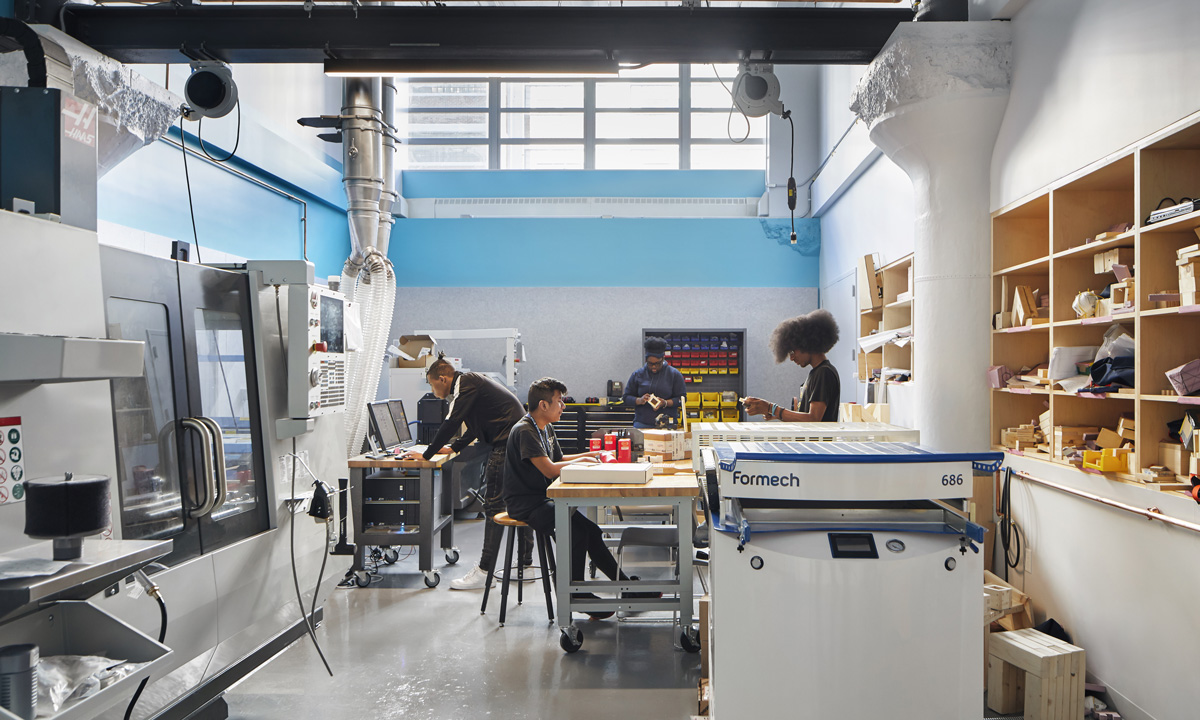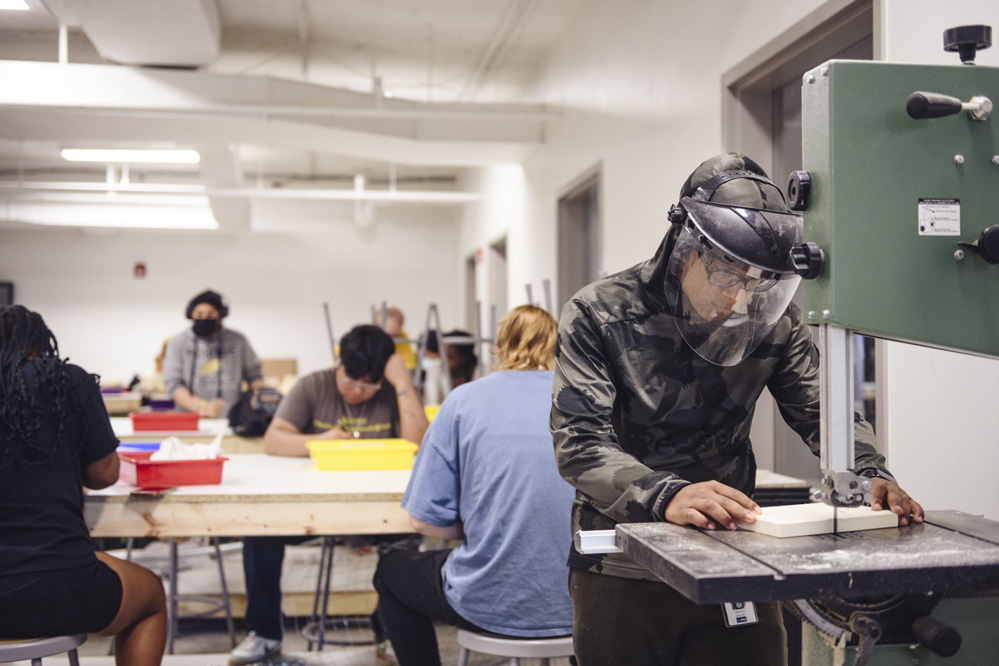There’s Already a Solution to the STEM Crisis: It’s in High Schools
Some solutions include creating a sense of joy and belonging in the classroom and making the high school schedule less rigid.

Get stories like these delivered straight to your inbox. Sign up for The 74 Newsletter
As generative artificial intelligence has captured our imaginations and civilians are rocketed into space, the allure of the STEM fields has never been stronger. At the same time, from food insecurity to the existential threat of climate change, almost every challenge facing our world today relies on creative solutions from people trained in science, technology, engineering and mathematics. The generation poised to inherit these crises, and with the most incentive to solve them, is sitting in high schools right now.
Yet, 41 years after “A Nation At Risk” caused widespread panic about our public schools, fewer than half of American students are graduating high school ready for college or career. U.S. teens performed lower on the latest international math test than students in many other countries, including the United Kingdom, Germany, South Korea and Estonia.
When young people are discouraged from pursuing a STEM-related career, they get locked out of 15 of the top 20 fastest-growing occupations, all of which come with family-sustaining salaries. And that means we all lose out — because the jobs needed to keep our country running go unfilled, and the inventions, treatments and technologies for our rapidly changing society go undiscovered.
Our two organizations, XQ Institute and Beyond100K, are deeply committed to ensuring all students have access to joyful and rigorous schools where they know they belong and can succeed. Research shows those three qualities — joy, rigor, and a sense of belonging — will prepare them for the future, whether that’s STEM or any other pursuit.
XQ partners with schools and districts to rethink the high school experience by making learning more meaningful and engaging through tools such as our Design Principles and Learner Outcomes. Beyond100K unites leading STEM organizations to co-develop and implement solutions to end the STEM teacher shortage by 2043, especially for those most excluded from STEM opportunities.
Sparking Joy in STEM
Guided by stories and insight from young people across the country, Beyond100K heard that to help spark the brilliance of millions more young minds, schools need to prioritize a focus on equity, representation, and especially belonging in STEM education. But that’s an increasingly difficult job.
Based on a recent analysis conducted by Beyond100K, it’s clear that schools and educators are facing dueling pressures. They’re tasked with reshaping classrooms to foster inclusivity and joy while developing career- and culturally-relevant curricula. Simultaneously, they’re under heightened scrutiny due to residual pandemic learning loss, ongoing declines in math and literacy standardized test scores, and challenges to social-emotional learning and teen mental health.
Beyond100K interviewed educators who expressed concerns about the fear of repercussions for teaching about bias and inequity and the difficulty of creating classrooms of belonging amid pressure to focus solely on raising test scores. Identities of teachers were kept anonymous.
One teacher noted that they are“scared to talk about the right thing, doing their own self-work to be able to talk about culture relative to their work….Regulations in states prevent teachers from having these conversations.”
Yet research demonstrates a positive correlation between a sense of belonging in STEM classrooms and academic performance, retention, and persistence — particularly for Black, Latino, and Native American students. Similarly, students engaged in SEL programs improve academic performance and social well-being.
Given that nearly 60% of girls and young women who were interested in STEM careers when they entered high school lost interest by the time they entered college, there is no question that developing a sense of belonging in the STEM fields is an essential element in nurturing learning environments that lead to STEM persistence. The rigidity of high school STEM education is preventing too many students from pursuing their dreams.
We see an emerging trend: many teachers and other education leaders view joy, belonging and relevance not in conflict with academic rigor, but as the pathway by which academic success can be achieved. Evidence supports the idea that joy-based learning leads to better academic outcomes, particularly for students of color.
The Beyond100K Foundational Math CoLaboratory, composed of partners from across the STEM learning ecosystem, has developed a repository of joyful mathematical resources and activities for educators and families to use in making math joyful for their students.
One Beyond100Kpartner, Community Resources for Science, employs a student-belonging-centered science teaching approach in their Bay Area Scientists Inspiring Students program, where scientist and engineer role models bring real-world connections, diversity, and inquiry-based learning into school environments. Teachers observed that students who engaged with these career scientists demonstrated skills above their typical classroom level.

Eliminating Systemic Barriers in High School
Creating a greater sense of belonging is one way to encourage teens to enter STEM. But our young people — and our creativity — are also trapped by a structural problem. The American education system, as we know it today, was built around the Carnegie Unit, or “credit hour,” a concept developed in 1906 that defines the amount of time a student needs to devote to learning a subject and earning a degree.
The Carnegie Unit made sense in its day, bringing order and even a degree of equity to a disconnected system. But that day has passed. There’s no need to limit math, science, English and other required subjects to 50-minute classes with no relationship to one another or to how learning relates to the world beyond the classroom. The Carnegie Unit as we know it today kills student curiosity, inhibits exploration and keeps educators from looking beyond the walls of their school to their communities and our world. Not to mention that clinging to a system that prioritizes time in the classroom over mastery of a subject is actually contributing to the inequity it was designed to prevent.
We are long overdue for a new architecture of learning. It is time to redefine and re-credentialize what it means to be a high school graduate. It’s time to develop new ways to teach, learn, measure and recognize student achievement, knowledge and growth. We can and must offer young people more immersive, relevant, hands-on experiences that prepare them for a rapidly changing world.
That’s our mission at XQ. When we launched in 2015 with an open call to design a transformational high school, 50,000 people signed up. Today, we’re working in about 60 schools. We have teamed up with school districts in Washington, D.C., New York City and the state of Rhode Island to transform high schools at the system level. Partnership is the common ingredient for these high schools and others like them. They’re forging ahead with new designs based on feedback from their local communities. They take the best ideas and visions — from educators, students, parents and other stakeholders — and turn them into life-changing progress for young people.
Consider the Brooklyn STEAM Center, which is partnering with the computer engineering firm Nanotronics to offer students in the engineering and multimedia pathways an opportunity to take on industry-based projects and earn stipends for their work. Or the Purdue Polytechnic High Schools in Indiana, which resulted from a partnership between Purdue University, business leaders, the state and Indianapolis city leaders to increase the number of students from underrepresented backgrounds attending Purdue and going into STEM careers. PPHS students work on projects that combine math, science and other topics to solve local problems. PPHS has sent more than twice as many students to Purdue University as the entire Indianapolis Public Schools district, most of whom are students of color.
These examples are only a small sampling of the national movement to transform high schools. XQ and Beyond100K are just two of many organizations engaged in this essential work. Let’s do everything in our power to give our high school students the tools, resources and inspiration to make that possible. Ensuring that STEM education in high school is inclusive, relevant, engaging and rigorous will help every learner achieve their dreams — and ours — in a changing world that will depend on their ideas.
Want to learn more about how to create innovative high school experiences in STEM and subjects? Check out The XQ Xtra, a newsletter for educators that comes out twice a month. Sign up here.
Interested in how you can commit to ending the STEM teacher shortage? Learn more from Beyond100K.
Disclosure: The XQ Institute is a financial supporter of The 74.
Get stories like these delivered straight to your inbox. Sign up for The 74 Newsletter


